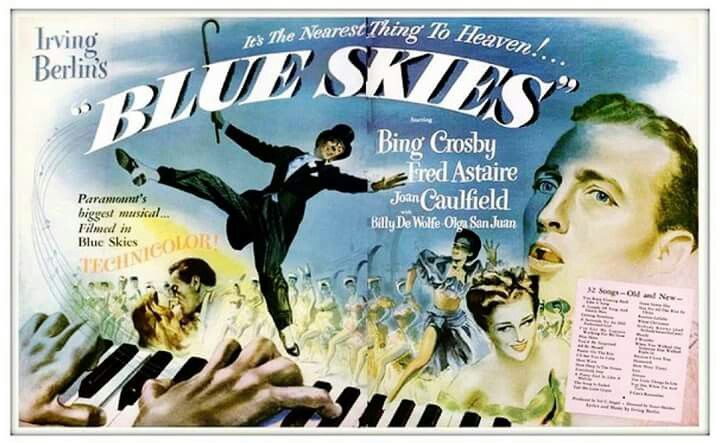Blue Skies Ahead, Dark Clouds Behind
DIRECTED BY STUART HEISLER/1946
STREET DATE: March 22nd, 2022/KINO LORBER STUDIO CLASSICS
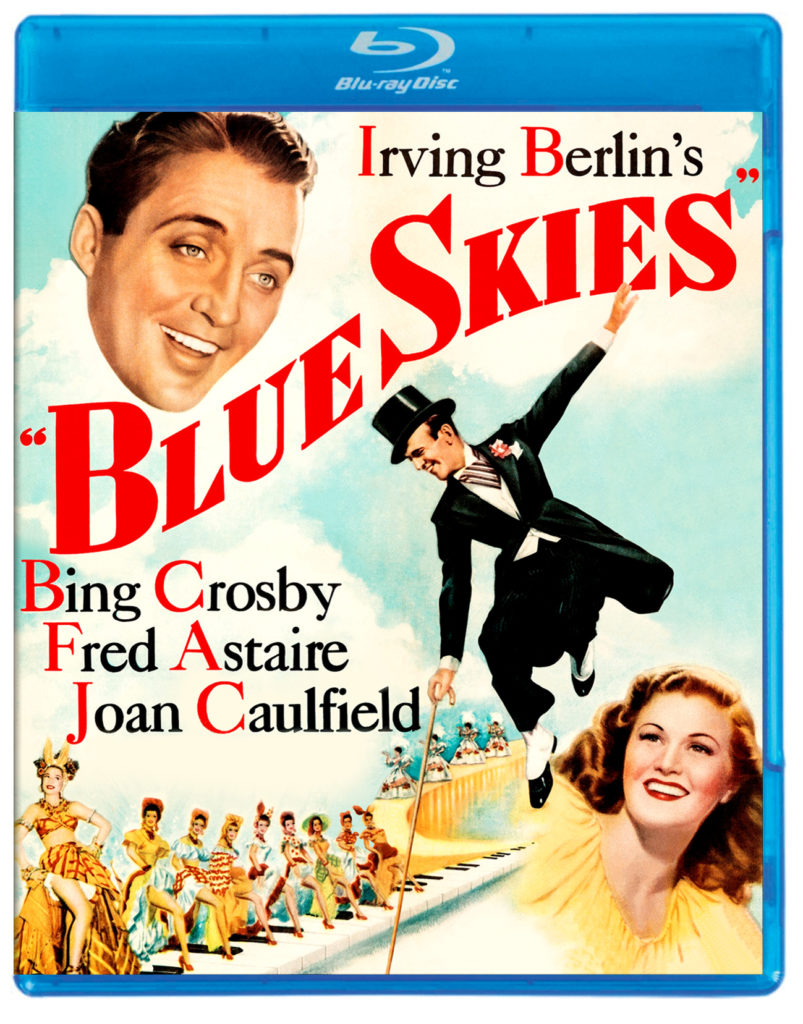
Irving Berlin’s 1926 tune “Blue Skies” provides the title for this 1946 musical compendium of some thirty Berlin hits written between 1919 and 1946. That twenty-five year period is dramatized by Paramount Studios in Technicolor and reunites 1942’s Holiday Inn co-stars Bing Crosby and Fred Astaire, whose screen partnership and romantic rivalry extends from that earlier Berlin musical to this postwar musical retrospective of the past two-and-a-half decades.
And just as there was always a girl in between those years and those men, played in Blue Skies by screen newcomer Joan Caulfield, so too did the songs themselves seem to musically describe the joys and pains of that eventful epoch. Looking back on those hopes, regrets, and memories, which include “A Pretty Girl is a Melody”, “You’d Be Surprised”, and “All By Myself”, another of five additional songs Berlin newly composed for this film further suggests something of the bittersweet quality of the gaps between life and the living of it that both fill up and drain away while marking time between wars. As the wistful and regret-tinged would have it, then: “You Keep Coming Back Like a Song”.
But time and experience, much like ambitious dancer Jed Potter (Fred Astaire) and laidback crooner Johnny Adams (Bing Crosby) – “A Couple of Song and Dance Men” according to both pop culture in general and this film in particular – are often at odds, and returning to the title and the title tune, “Blue Skies” initially appeared less than a year after first hitting the charts in the 1927 musical melodrama The Jazz Singer, credited as the first feature to fully synchronize sound, dialogue, and music. There, star Al Jolson as the title character, defying his rabbinical cantor father to whistle, stomp, slap, and whine the popular songs of the day, performs the recent Irving Berlin ditty in the family living room to his doting mother. While not too convincingly vamping on the parlor piano, Jolson nevertheless throws his head back in sheer abandon and rather convincingly embodies the aspirational lyric and melody for that time and place; Sonny Boy musically assuring Mammy that, in a nice bit of apparently improvised stage patter, the hard-working entertainer will one day succeed in moving the self-sacrificing maternal figure from the tenements of the Lower East Side on up to those modern luxury apartments in the Bronx.
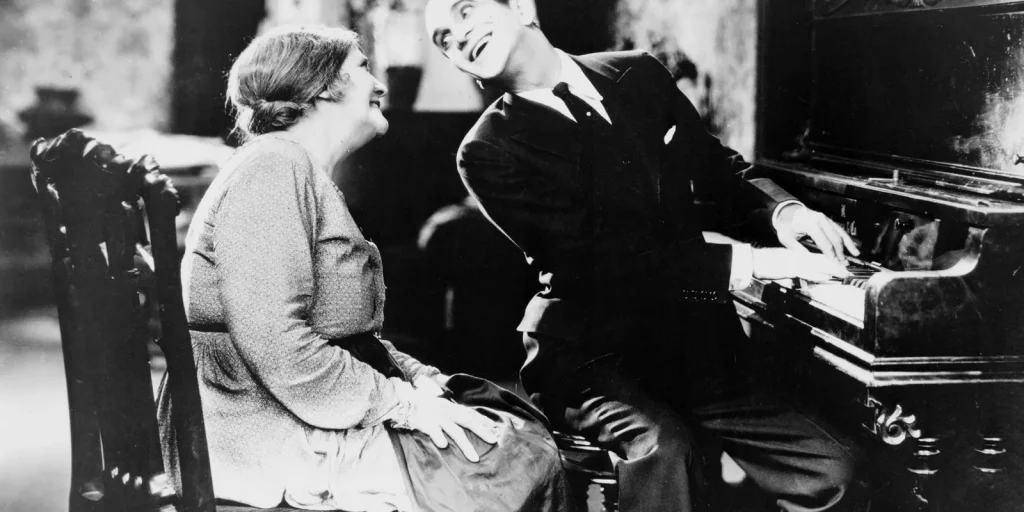
By 1946, however, Bing Crosby-as-Johnny Adams performing this very same song to Joan Caulfield-as-Mary O’Hara, the young actress then in fact the real-life paramour of the Catholic, middle-aged, and very married Buh-buh-buh-Bing!, has a very different meaning and context; the torrential downpour of a rained-out picnic capturing the leafy overhang and muddy ground beneath in vivid Technicolor with the ironic lyrical counterpoint of “Nothin’ but BLUE SKIES, for now on…” The sequence does pull out all the sound-and-visual stops by the end, with Johnny and Mary ascending a green hill as the rain clears to view the newly blue skies, but the couple’s expressions remain unreadable with their backs to us; dark figures in a bright landscape.
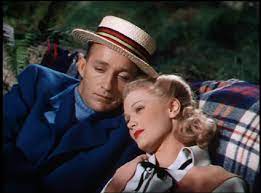
As for Fred Astaire, his Jed Potter may not have a romantic chance in this movie, but then Fred had already danced onscreen with Joan Crawford, Ginger Rogers, Rita Hayworth, Eleanor Powell, among others, and, in addition to announcing his retirement soon after this film (the first of many such “retirements”, as it turned out, his career continuing even into the 1980s), it is possibly appropriate that his character Jed ultimately should not be seriously romantically linked with an obvious non-hoofer like Joan Caulfield. Instead, we get Astaire’s top hat-and-coat tails solo performance of 1930’s “Puttin’ On the Ritz”, which itself had moved in the sixteen years since one Harry Richman first sang-and-danced about misfit Harlemites aping their social betters on Lenox Avenue to a more generalized, white, homogenized type, or undifferentiated non-types, ‘playing rich’ up on Park.
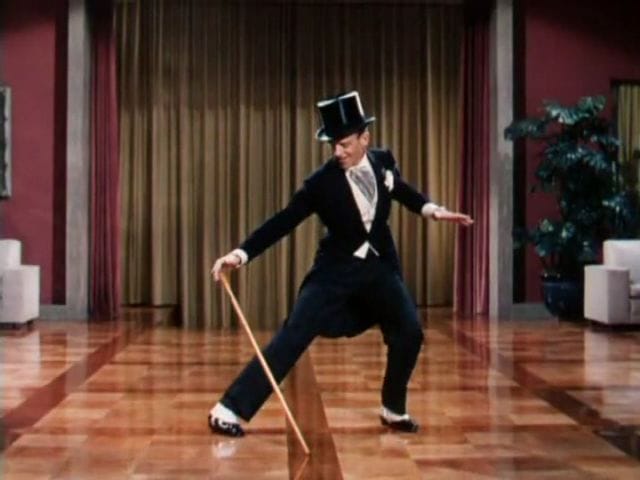
The performance, choreographed by Astaire’s dancing alter-ego Hermes Pan, is precise, electric, and even defiant; the notorious perfectionism of the performer on full display, rakish cane-work shooting to his outstretched hand on command, and naturally resolving through a literal hall of mirrors to a rear-projection of multiple Astaires, dancing virtuosically along in clockwork synchronicity. Lacking an equal dance partner, perhaps, only Astaire is worthy of dancing with Astaire.
That leaves about twenty-odd Berlin songs yet unmentioned or undescribed, but that also leaves worthy supporting players like the vivacious Olga San Juan, as ethnic-exotic Nita Nova, and the versatile Billy De Wolfe, as queer-coded Tony Toona, in the lurch, so the likes of “(I’ll See You in) C-U-B-A” and “I’ve Got My Captain Working For Me Now” are in good company. Bing as Johnny does tenderly abandon a child set to the plaintive tune “(Running Around in Circles) Getting Nowhere” and Fred as rhyming Jed drunkenly attempts professional and emotional suicide set to the splashy production number and thumping rhythms of “Heat Wave”, so similarly the mere mention may suffice for readers (and a reviewer) eager to get to the “Blue Skies/You Keep Coming Back Like a Song” reprise awaiting viewers at the end.
Kino Lorber Studio Classics’ Blu-ray comes remastered in video and audio, the fiery 2K-resolved visuals of the climactic number “Heat Wave”, say, matching the strong tropical beat of a veteran performer’s ‘final’ song. (But still again, Jed Potter in his “anecdotage” will bounce back to narrate the entire proceedings over the radio, and Fred Astaire will of course return triumphant a mere two years later in another Irving Berlin extravaganza, opposite Judy Garland, no less, in 1948’s Easter Parade.) Film critic Simon Abrams offers a feature-length commentary on this disc which balances history, context, and analysis of what he terms Irving Berlin’s “jukebox musical” – “Blue Skies” in its many settings, forms, and guises, basically – here defending a sometimes maligned movie musical and pointing out numerous, relevant connections to the work of the performers and composer preceding it.
In 1946, twenty years after introducing the title tune, Irving Berlin was fifty-eight years old, and would live another astonishing forty-three years. Berlin, the name by which young Israel Beilin succeeded in moving from lower to upper New York, ended up contributing some 1,250 chapters to the Great American Song Book, of which Blue Skies film-documents the century-length entertainer’s most dramatic and productive years. Whether brightness lay ahead as darkness receded behind remained yet unclear, but for anyone looking for a pop cultural snapshot of its era, from one of the most influential popular composers of the twentieth century, and as performed by two song-and-dance men equally epochal, one need look no further than this Technicolor, Paramount-produced, Berlin-composed, and Crosby-and-Astaire-performed evocation of a cerulean horizon painted over a dream-factory soundstage.
Images used in this review (from scant available sources) are used only as a visual reference to the film.
UPDATE: The Kino Lorber Studio Classics Facebook page reported an “audio error” during the tap dancing sequences of their initial Blu-ray release of Blue Skies. Those affected by the issue can order a replacement disc at the following web address: https://www.kinolorber.com/page/blue-skies-replacement-program


